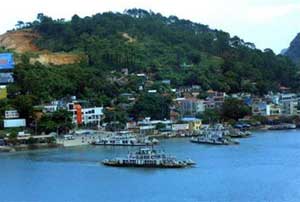 On the afternoon of December 16, in Hanoi, the Ministry of Natural Resources and Environment announced the 2005 Environmental Status Report. This report is considered a “manual” on environmental issues for managers, policymakers, scientists, researchers, and everyone interested in the environmental situation in Vietnam.
On the afternoon of December 16, in Hanoi, the Ministry of Natural Resources and Environment announced the 2005 Environmental Status Report. This report is considered a “manual” on environmental issues for managers, policymakers, scientists, researchers, and everyone interested in the environmental situation in Vietnam.
The 2005 National Environmental Status Report was developed based on a clear understanding of the importance of environmental protection (EP) and the challenges currently faced as the country prepares to implement the socio-economic development plan for the 2006-2010 period and become an official member of the WTO.
The current environmental status is specifically outlined as follows: Freshwater environments are increasingly polluted, with surface water pollution becoming severe, particularly in river basins and small rivers and canals within urban areas. Groundwater is also facing pollution and localized salinization, leading to a significant decline in both the quality and quantity of water resources.
Marine environments face escalating pollution risks due to human activities, especially in areas with concentrated urban populations and industrial facilities.
Air quality is critically impacted in urban areas, industrial zones, and some craft villages, negatively affecting human health, ecosystems, and contributing to climate change. The main air pollutants include SO2, NO2, CO, H2S, suspended dust, lead, and volatile organic compounds. Current environmental monitoring data indicates that the air in major urban areas is polluted by dust and CO, while air quality in rural areas remains relatively good.
Soil pollution is exacerbated by the use of chemical fertilizers, pesticide contamination, and waste disposal, leading to land degradation and desertification. According to the data from the Desertification Convention coordination office, Vietnam currently has about 7,055,000 hectares severely affected by desertification, concentrated in central provinces; soil erosion in the Northwest and Central Highlands; salinization and acid sulfate soils in the Mekong Delta; and seasonal or permanent drought conditions in the South Central region.
Solid waste is primarily generated in urban areas. Statistics show that the average amount of municipal solid waste is approximately 0.6-0.9 kg/person/day in major cities and fluctuates from 0.4-0.5 kg/person/day in smaller towns. Hazardous waste originates from craft village activities, industrial production, and healthcare. The total amount of hazardous solid waste from craft villages nationwide is about 2,400 tons/year (from Bac Ninh, Ha Tay, Hanoi, Hung Yen, etc.). The amount of medical hazardous waste requiring treatment is approximately 34 tons/day…
Vietnam’s biodiversity is also facing significant degradation risks due to various factors such as: unplanned land-use changes; unsustainable exploitation and use of biological resources; invasive alien species; environmental pollution; forest fires; and natural disasters…
Additionally, there have been natural calamities and environmental incidents, including storms and floods over the past year, causing substantial damage to both lives and property.
Key environmental issues highlighted in 2004 and early 2005 are discussed in five chapters of the 2005 Environmental Status Report, which also proposes several measures to address these environmental challenges.
Mr. Tran Hong Ha, Director of the Department of Environmental Protection (Ministry of Natural Resources and Environment), stated that the report will serve as a valuable resource for members of parliament, managers, policymakers, scientists, researchers, and everyone interested in environmental protection efforts in Vietnam.




















































